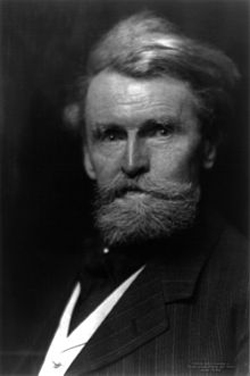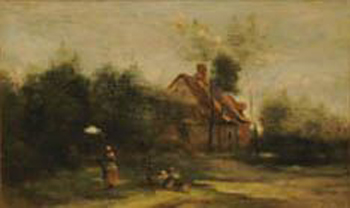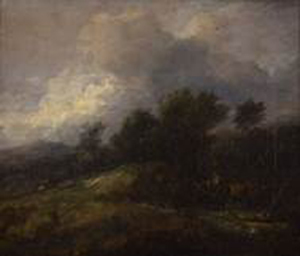Copper King’s Art Collection Plays Role in Montana's History
Copper mining was behind the wealth of “Copper King” William Andrews Clark, an entrepreneur from Montana who amassed an art collection that is the current focus of an exhibition at the Montana Museum of Art & Culture. The nine rare works on display span 500 years, including new gifts from the Trustees of the Corcoran Gallery of Art to the MMAC Permanent Collection located at the University of Montana.
“I think it’s almost like a small survey of the best of European art through 500 years,” says Barbara Koostra, the museum’s director.
 William Andrews Clark, aka “The Copper King”
William Andrews Clark, aka “The Copper King”Photograph courtesy of Wikipedia.org.
The exhibition features works by Jean-Baptiste-Camille Corot, Jean-Charles Cazin, Jules Dupré, Jean-Honoré Fragonard, Thomas Gainsborough, and a sculpture attributed to Donatello. Previously, the Corcoran Gallery of Art was home to Clarke’s entire collection.
“When they dissolved in 2014 the works within the collection were disseminated,” Koostra says. “99.4% went to Washington, D.C. institutions so we were an outlier in that mix.”
It was a two-year process for the MMAC to acquire the art, that began with putting a request in that was centered on making a case that some of Clarke’s wealth should return to the state of Montana.
“Given the history of William A. Clarke in our state and his importance as a “Copper King” we put in a request that some of his treasures of his collection be in Montana,” Koostra says. “The place where his wealth and riches originated.”
Born in 1839, Clark, a former Montana senator, had mining operations based in Butte and Anaconda, Montana.
“There was a feeling on our part that these treasures could be some sort of symbolic measure of what he has done with the Montana earth,” she says.
 Jean-Baptiste-Camille Corot, Scene near Douai: Children,
Jean-Baptiste-Camille Corot, Scene near Douai: Children,
Undated, Oil on panel, 12¾ x 19¼" (Unframed), MMAC
Permanent Collection. Gift by transfer from Corcoran Gallery
of Art.
Photograph courtesy of Montana Museum of Art & Culture.
Today, visitors can visit his former residence in Butte, MT, known as The Copper King’s Mansion, to learn about his life, career and business ventures which spanned the continent as a result of his copper wealth. Clark owned newspapers in Montana and Utah including The Butte Miner, The Great Falls Tribune, and The Salt Lake Herald, sugar plantations in California and oil wells in Long Beach, California. In Elizabeth, New Jersey he owned the W. A. Clark Wire Company, one of the largest in the country. In New York, he owned the Henry Bonnard Bronze Company.
Tours at The Copper Mansion cover the many interesting facets of his life, including the fact that Clark is probably the only man ever to personally finance the development of a railroad. Rather than issuing stock or using corporate capital, the railroad was completely financed by his private fortune. The railroad and its branches ran for 1,100 miles and eventually became part of the Union Pacific Railroad. During tours, they recall how Clark owned property in Nevada which he developed as a ranch for his railroad workers and miners to recover from chronic diseases in the dry desert climate. He later sold this property to make way for the development of a modest plot of desert known as Las Vegas -- which is located in Clark County, named after him.
He controlled mining interests in Arizona and Montana. In Arizona, he owned 97 percent of the United Verde Mining Company in Jerome and founded the town of Clarkdale, Arizona.
The museum used Clark’s copper roots to help acquire the rare works of art for the gallery. Support for the museum to acquire the pieces came from many different angles.
“There was an understanding of the Board of Trustees and we had advocates and champions who helped secure the gift,” she says.
Koostra discusses how the acquisition of the works has impacted their catlog of .
 Thomas Gainsborough, A Market Cart, Undated,
Thomas Gainsborough, A Market Cart, Undated,
Oil on canvas, 15¾ x 18" (Framed), MMAC Permanent
Collection. Gift by transfer from Corcoran Gallery of Art
Photograph courtesy of Montana Museum of Art & Culture.
“It is an incredibly important increase in the value of our permanent collection,” she says. “It is a wonderful addition of masterpieces to the beautiful collection we already had.”
Throughout the exhibition of Clark’s pieces they have an extensive amount of wall text that includes background on Clark’s life.
“He was quite an entrepreneur,” she says. “He amassed such wealth and a remarkable art collection.”
They utilized some internal resources at the University when conducting research in preparation for the exhibition.
“We have a gentleman who is a faculty member and he is writing a biography of Clark,” Koostra says. “He was helpful in setting the stage.”
Clark was one of three “Copper Kings” of Butte, along with Marcus Daly and Frederick Heinze.
“They were competitive and tried to outdo each other in many ways,” Koostra says. “He and Daly were definitely political enemies.”
Thus far, Koostra says visitors to the museum have appreciated seeing the works ever since they have been on display beginning last month. Recently, some freshman students from the University came in to see the exhibition and Koostra said they were stuck by the Donatello piece.
“I think people are quite riveted,” she says. “Just the sheer age of something like that and the beauty of it — we have people in disbelief.”
During the course of the school year, when the works will be on display on campus, the museum will be offering programming that creates context for the works.
“It is up longer than a traditional exhibition,” she says. “For this one, we really wanted to make it accessible at this time.”
Resources:
Also in this Issue:
- Copper King’s Art Collection Plays Role in Montana's History
- Fisher Forging His Way Into Homes
- Money Museum Showcases Million Dollar 1943 Cent
- The Body Transformed Examines the Purpose and Power of Jewelry
- San Antonio Zoo Raises Awareness of White Rhino Extinction with Iconic Bronze Sculpture
